In 2004, a tsunami devastated much of the Indonesian city of Banda Aceh. New research identifies an unfortunate result of the reconstruction: lower-income residents are now disproportionately exposed to coastal hazards.
The massive tsunami leveled nearly half of the city and killed an estimated 160,000 people across the province. Countless others lost their families, homes, and everything they owned.
In the years that followed, aid providers rebuilt homes on the same plots that the tsunami had completely destroyed, in order to avoid displacing the residents. In doing so, they were acting in accordance with a humanitarian principle that comes into play after natural disasters: to help survivors to return to their previous places of residence whenever possible.
Yet in Banda Aceh, many tsunami survivors preferred to move inland instead, leading to a price premium for properties farther from the coast and socio-economic segregation.
Reconstruction in the coastal zone has unintentionally exacerbated this segregation: now many lower-income newcomers rent rebuilt houses that higher-income tsunami survivors do not want to occupy.
The researchers report their findings in Nature Sustainability.
Newcomers on the coast
“The reconstruction of Banda Aceh had a goal to ‘build back better,'” says Jamie McCaughey, first author of the study and a doctoral student of ETH Zurich professor Anthony Patt. This principle applied not only to the rebuilding of houses and infrastructure, but also to people’s well-being. “While there were many successes, the reconstruction efforts did not always pan out as intended,” concludes McCaughey and the team of researchers from the Earth Observatory of Singapore, Nanyang Technological University in Singapore, and Syiah Kuala University in Banda Aceh.
Rising demand for properties in tsunami-safe locations further inland triggered a price explosion.
In 2014-15, researchers analyzed the socioeconomic characteristics of both rebuilt and unaffected residential areas and interviewed hundreds of people: tsunami survivors, newcomers, community leaders, and agency and government officials.
The researchers found that nearly all of the homes rebuilt in the tsunami-affected area were inhabited ten years later. Yet only half of the inhabitants were tsunami survivors. Over 40 percent of the people living in the new houses were newcomers: mostly lower-income renters from other regions who had not witnessed the tsunami.
According to the researchers, many tsunami survivors either never returned to live in the aid houses provided on their plots, or returned and soon left. People who could afford it settled in the more inland parts of the city, while renting out their aid house to others. “And some tsunami survivors who returned and ended up staying would like to move farther from the coast but cannot afford to do so,” says McCaughey.
This is because the rising demand for properties in tsunami-safe locations further inland had triggered a price explosion. Real estate and land prices increased sharply, making homes in tsunami-safe locations unaffordable to poorer residents wanting to move there. At the same time, the rental prices dropped for the newly built homes near the coast, drawing in poorer residents.
Segregation
Ultimately, this has led to a division in the urban population—with poor residents who can no longer afford to live in tsunami-safe locations on one side, and affluent residents on the other. “Before the tsunami, people did not know about tsunami risk, so there was no socioeconomic segregation of tsunami-prone areas. But now wealthier households tend to live further inland, while poorer households tend to live near the coast,” says McCaughey.
“In an era of growing coastal populations and rising sea levels, decisions made after one disaster strongly influence our vulnerability to the next.”
According to McCaughey, one way to avoid this undesirable segregation would be to let people choose where they receive housing aid after the disaster, regardless of their purchasing power. “Enabling people to choose where they rebuild would help those who truly wish to return to the coast to do so; at the same time, this may avoid the problems that arise from rebuilding more houses than wanted in hazard-exposed areas,” he says. Nine in ten interviewees said that they did not receive this choice, however.
But it was also reported that there were many who did willingly move back to the coastal zones. “They were thankful for the aid that allowed them to resume a normal life in their familiar surroundings.” Given these diverse preferences, “we find that one size does not fit all.”
When rebuilding in disaster areas, aid organizations and government agencies have to decide where to relocate people. “After the disaster, there was also a lot of pressure from donors to quickly rebuild the parts of the city that were destroyed,” says McCaughey. Another factor was that the local authorities did not have funds for land purchases. “This limited the possibilities for relocation from the outset.”
Relocation has its disadvantages, too, however: in places destroyed by the same tsunami in Sri Lanka, the authorities created buffer zones that prohibited new construction. The former inhabitants of these areas relocated. The new homes and people are safe from future tsunamis, but residents now have to deal with long journeys and expensive transit costs to get to work.
The case of Banda Aceh, however, is not necessarily representative of all of the disaster areas rebuilt after the tsunami. “Other cases must be considered individually,” says McCaughey.
“In an era of growing coastal populations and rising sea levels, decisions made after one disaster strongly influence our vulnerability to the next.”
Source: ETH Zurich



